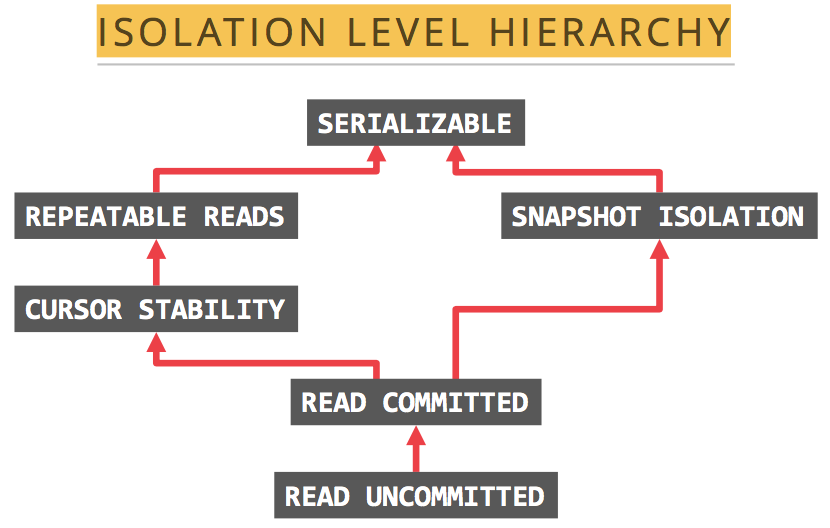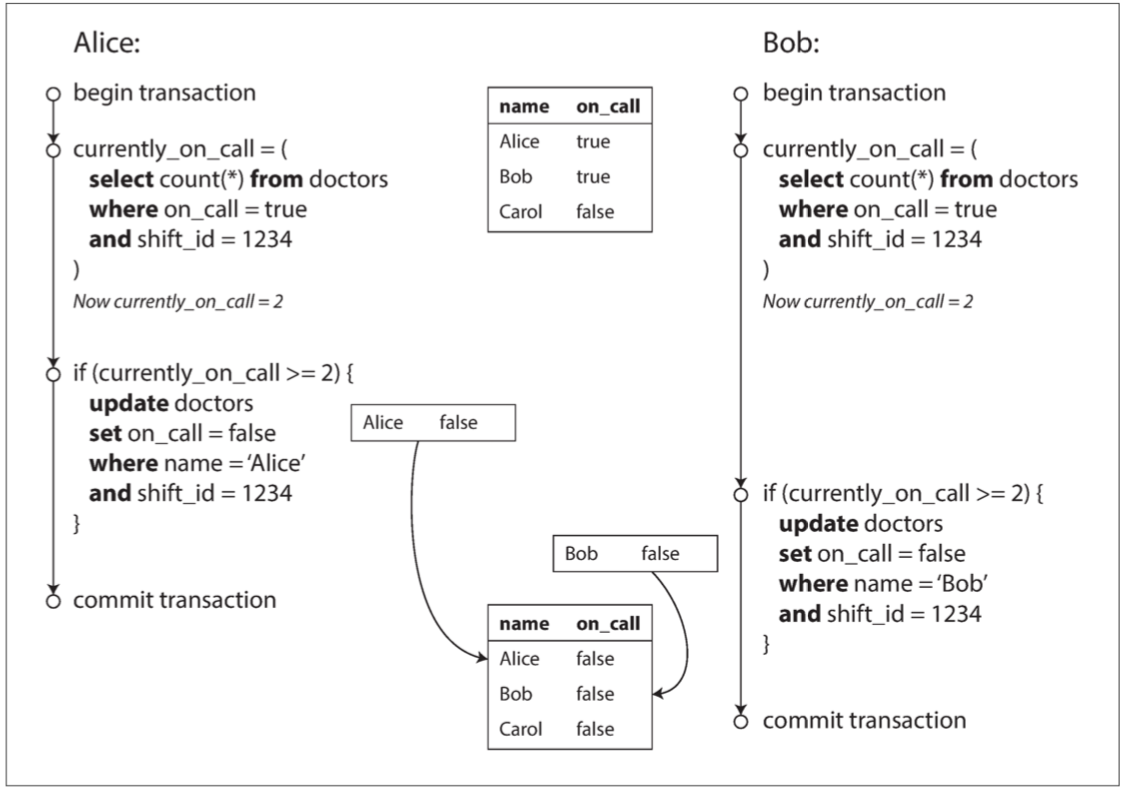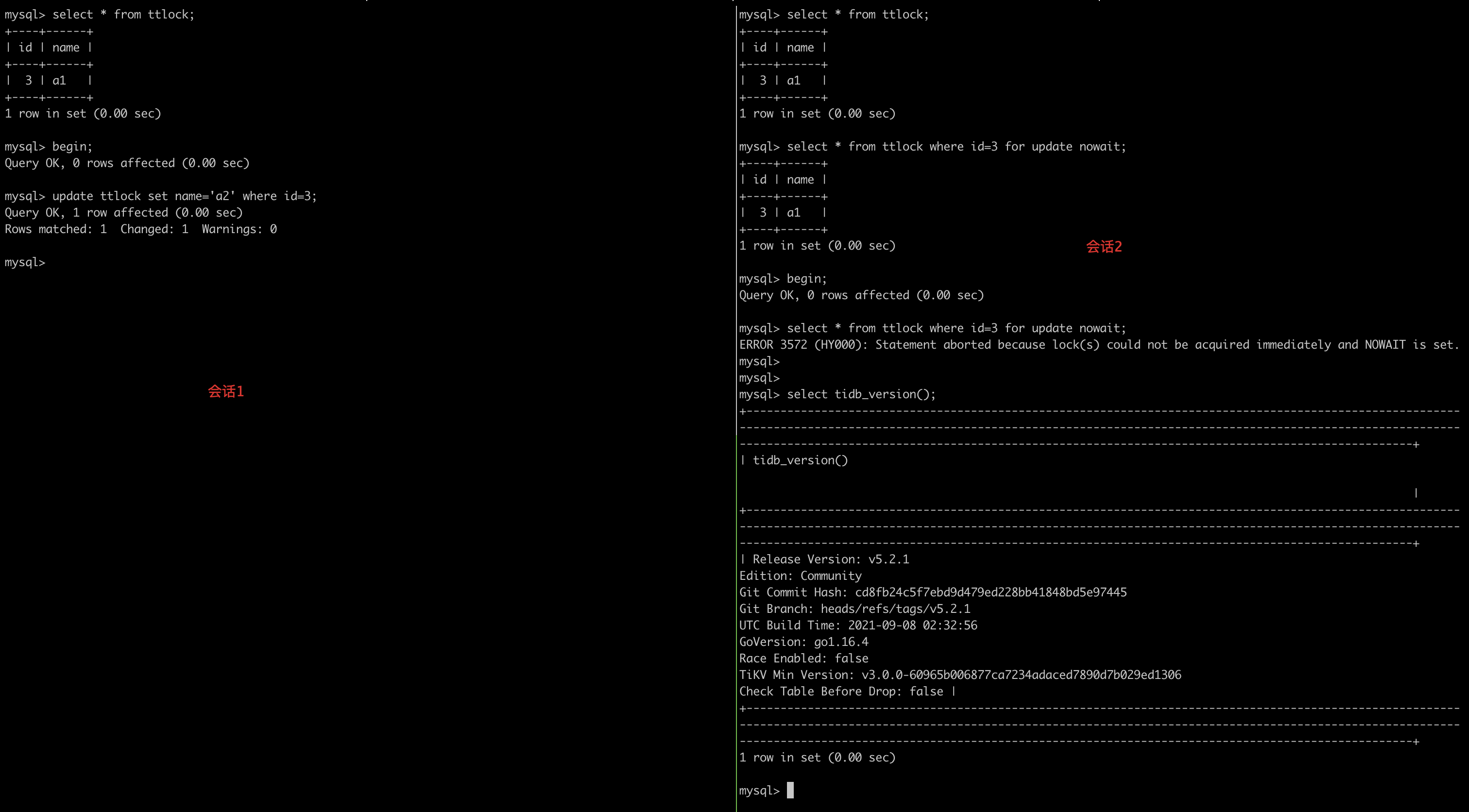黄东旭解析 TiDB 的核心优势
1107
2023-07-14
本文关于(TiDB中的事务限制-平凯星辰)。
本章将简单介绍 TiDB 中的事务限制。
TiDB 支持的隔离级别是 RC(Read Committed)与 SI(Snapshot Isolation),其中 SI 与 RR(Repeatable Read)隔离级别基本等价。

TiDB 的 SI 隔离级别可以克服幻读异常 (Phantom Reads),但 ANSI/ISO SQL 标准中的 RR 不能。
所谓幻读是指:事务 A 首先根据条件查询得到 n 条记录,然后事务 B 改变了这 n 条记录之外的 m 条记录或者增添了 m 条符合事务 A 查询条件的记录,导致事务 A 再次发起请求时发现有 n+m 条符合条件记录,就产生了幻读。
例如:系统管理员 A 将数据库中所有学生的成绩从具体分数改为 ABCDE 等级,但是系统管理员 B 就在这个时候插入了一条具体分数的记录,当系统管理员 A 改结束后发现还有一条记录没有改过来平凯星辰,就好像发生了幻觉一样,这就叫幻读。
TiDB 的 SI 隔离级别不能克服写偏斜异常(Write Skew),需要使用 Select for update 语法来克服写偏斜异常。
写偏斜异常是指两个并发的事务读取了不同但相关的记录,接着这两个事务各自更新了自己读到的数据,并最终都提交了事务,如果这些相关的记录之间存在着不能被多个事务并发修改的约束,那么最终结果将是违反约束的。
举个例子,假设你正在为医院写一个医生轮班管理程序。医院通常会同时要求几位医生待命,但底线是至少有一位医生在待命。医生可以放弃他们的班次(例如,如果他们自己生病了),只要至少有一个同事在这一班中继续工作。
现在出现这样一种情况,Alice 和 Bob 是两位值班医生。两人都感到不适,所以他们都决定请假。不幸的是,他们恰好在同一时间点击按钮下班。下面用程序来模拟一下这个过程。
Java
Golang
Java 程序示例如下:
package com.pingcap.txn.write.skew;import com.zaxxer.hikari.HikariDataSource;import java.sql.Connection;import java.sql.PreparedStatement;import java.sql.ResultSet;import java.sql.SQLException;import java.util.concurrent.CountDownLatch;import java.util.concurrent.ExecutorService;import java.util.concurrent.Executors;import java.util.concurrent.Semaphore;public class EffectWriteSkew { public static void main(String[] args) throws SQLException, InterruptedException { HikariDataSource ds = new HikariDataSource(); ds.setJdbcUrl("jdbc:mysql://localhost:4000/test?useServerPrepStmts=true&cachePrepStmts=true"); ds.setUsername("root"); // prepare data Connection connection = ds.getConnection(); createDoctorTable(connection); createDoctor(connection, 1, "Alice", true, 123); createDoctor(connection, 2, "Bob", true, 123); createDoctor(connection, 3, "Carol", false, 123); Semaphore txn1Pass = new Semaphore(0); CountDownLatch countDownLatch = new CountDownLatch(2); ExecutorService threadPool = Executors.newFixedThreadPool(2); threadPool.execute(() -> { askForLeave(ds, txn1Pass, 1, 1); countDownLatch.countDown(); }); threadPool.execute(() -> { askForLeave(ds, txn1Pass, 2, 2); countDownLatch.countDown(); }); countDownLatch.await(); } public static void createDoctorTable(Connection connection) throws SQLException { connection.createStatement().executeUpdate("CREATE TABLE `doctors` (" + " `id` int(11) NOT NULL," + " `name` varchar(255) DEFAULT NULL," + " `on_call` tinyint(1) DEFAULT NULL," + " `shift_id` int(11) DEFAULT NULL," + " PRIMARY KEY (`id`)," + " KEY `idx_shift_id` (`shift_id`)" + " ) ENGINE=InnoDB DEFAULT CHARSET=utf8mb4 COLLATE=utf8mb4_bin"); } public static void createDoctor(Connection connection, Integer id, String name, Boolean onCall, Integer shiftID) throws SQLException { PreparedStatement insert = connection.prepareStatement( "INSERT INTO `doctors` (`id`, `name`, `on_call`, `shift_id`) VALUES (?, ?, ?, ?)"); insert.setInt(1, id); insert.setString(2, name); insert.setBoolean(3, onCall); insert.setInt(4, shiftID); insert.executeUpdate(); } public static void askForLeave(HikariDataSource ds, Semaphore txn1Pass, Integer txnID, Integer doctorID) { try(Connection connection = ds.getConnection()) { try { connection.setAutoCommit(false); String comment = txnID == 2 ? " " : "" + "/* txn #{txn_id} */ "; connection.createStatement().executeUpdate(comment + "BEGIN"); // Txn 1 should be waiting until txn 2 is done. if (txnID == 1) { txn1Pass.acquire(); } PreparedStatement currentOnCallQuery = connection.prepareStatement(comment + "SELECT COUNT(*) AS `count` FROM `doctors` WHERE `on_call` = ? AND `shift_id` = ?"); currentOnCallQuery.setBoolean(1, true); currentOnCallQuery.setInt(2, 123); ResultSet res = currentOnCallQuery.executeQuery(); if (!res.next()) { throw new RuntimeException("error query"); } else { int count = res.getInt("count"); if (count >= 2) { // If current on-call doctor has 2 or more, this doctor can leave PreparedStatement insert = connection.prepareStatement( comment + "UPDATE `doctors` SET `on_call` = ? WHERE `id` = ? AND `shift_id` = ?"); insert.setBoolean(1, false); insert.setInt(2, doctorID); insert.setInt(3, 123); insert.executeUpdate(); connection.commit(); } else { throw new RuntimeException("At least one doctor is on call"); } } // Txn 2 is done. Let txn 1 run again. if (txnID == 2) { txn1Pass.release(); } } catch (Exception e) { // If got any error, you should roll back, data is priceless connection.rollback(); e.printStackTrace(); } } catch (SQLException e) { e.printStackTrace(); } }}SQL 日志:
/* txn 1 */ BEGIN /* txn 2 */ BEGIN /* txn 2 */ SELECT COUNT(*) as `count` FROM `doctors` WHERE `on_call` = 1 AND `shift_id` = 123 /* txn 2 */ UPDATE `doctors` SET `on_call` = 0 WHERE `id` = 2 AND `shift_id` = 123 /* txn 2 */ COMMIT/* txn 1 */ SELECT COUNT(*) AS `count` FROM `doctors` WHERE `on_call` = 1 and `shift_id` = 123/* txn 1 */ UPDATE `doctors` SET `on_call` = 0 WHERE `id` = 1 AND `shift_id` = 123/* txn 1 */ COMMIT
执行结果:
mysql> SELECT * FROM doctors;+----+-------+---------+----------+| id | name | on_call | shift_id |+----+-------+---------+----------+| 1 | Alice | 0 | 123 || 2 | Bob | 0 | 123 || 3 | Carol | 0 | 123 |+----+-------+---------+----------+
在两个事务中,应用首先检查是否有两个或以上的医生正在值班;如果是的话,它就假定一名医生可以安全地休班。由于数据库使用快照隔离,两次检查都返回 2,所以两个事务都进入下一个阶段。Alice 更新自己的记录休班了,而 Bob 也做了一样的事情。两个事务都成功提交了,现在没有医生值班了。违反了至少有一名医生在值班的要求。下图(引用自《Designing Data-Intensive Application》)说明了实际发生的情况:

现在更改示例程序,使用 SELECT FOR UPDATE 来克服写偏斜问题:
Java
Golang
Java 中使用 SELECT FOR UPDATE 来克服写偏斜问题的示例如下:
package com.pingcap.txn.write.skew;import com.zaxxer.hikari.HikariDataSource;import java.sql.Connection;import java.sql.PreparedStatement;import java.sql.ResultSet;import java.sql.SQLException;import java.util.concurrent.CountDownLatch;import java.util.concurrent.ExecutorService;import java.util.concurrent.Executors;import java.util.concurrent.Semaphore;public class EffectWriteSkew { public static void main(String[] args) throws SQLException, InterruptedException { HikariDataSource ds = new HikariDataSource(); ds.setJdbcUrl("jdbc:mysql://localhost:4000/test?useServerPrepStmts=true&cachePrepStmts=true"); ds.setUsername("root"); // prepare data Connection connection = ds.getConnection(); createDoctorTable(connection); createDoctor(connection, 1, "Alice", true, 123); createDoctor(connection, 2, "Bob", true, 123); createDoctor(connection, 3, "Carol", false, 123); Semaphore txn1Pass = new Semaphore(0); CountDownLatch countDownLatch = new CountDownLatch(2); ExecutorService threadPool = Executors.newFixedThreadPool(2); threadPool.execute(() -> { askForLeave(ds, txn1Pass, 1, 1); countDownLatch.countDown(); }); threadPool.execute(() -> { askForLeave(ds, txn1Pass, 2, 2); countDownLatch.countDown(); }); countDownLatch.await(); } public static void createDoctorTable(Connection connection) throws SQLException { connection.createStatement().executeUpdate("CREATE TABLE `doctors` (" + " `id` int(11) NOT NULL," + " `name` varchar(255) DEFAULT NULL," + " `on_call` tinyint(1) DEFAULT NULL," + " `shift_id` int(11) DEFAULT NULL," + " PRIMARY KEY (`id`)," + " KEY `idx_shift_id` (`shift_id`)" + " ) ENGINE=InnoDB DEFAULT CHARSET=utf8mb4 COLLATE=utf8mb4_bin"); } public static void createDoctor(Connection connection, Integer id, String name, Boolean onCall, Integer shiftID) throws SQLException { PreparedStatement insert = connection.prepareStatement( "INSERT INTO `doctors` (`id`, `name`, `on_call`, `shift_id`) VALUES (?, ?, ?, ?)"); insert.setInt(1, id); insert.setString(2, name); insert.setBoolean(3, onCall); insert.setInt(4, shiftID); insert.executeUpdate(); } public static void askForLeave(HikariDataSource ds, Semaphore txn1Pass, Integer txnID, Integer doctorID) { try(Connection connection = ds.getConnection()) { try { connection.setAutoCommit(false); String comment = txnID == 2 ? " " : "" + "/* txn #{txn_id} */ "; connection.createStatement().executeUpdate(comment + "BEGIN"); // Txn 1 should be waiting until txn 2 is done. if (txnID == 1) { txn1Pass.acquire(); } PreparedStatement currentOnCallQuery = connection.prepareStatement(comment + "SELECT COUNT(*) AS `count` FROM `doctors` WHERE `on_call` = ? AND `shift_id` = ? FOR UPDATE"); currentOnCallQuery.setBoolean(1, true); currentOnCallQuery.setInt(2, 123); ResultSet res = currentOnCallQuery.executeQuery(); if (!res.next()) { throw new RuntimeException("error query"); } else { int count = res.getInt("count"); if (count >= 2) { // If current on-call doctor has 2 or more, this doctor can leave PreparedStatement insert = connection.prepareStatement( comment + "UPDATE `doctors` SET `on_call` = ? WHERE `id` = ? AND `shift_id` = ?"); insert.setBoolean(1, false); insert.setInt(2, doctorID); insert.setInt(3, 123); insert.executeUpdate(); connection.commit(); } else { throw new RuntimeException("At least one doctor is on call"); } } // Txn 2 is done. Let txn 1 run again. if (txnID == 2) { txn1Pass.release(); } } catch (Exception e) { // If got any error, you should roll back, data is priceless connection.rollback(); e.printStackTrace(); } } catch (SQLException e) { e.printStackTrace(); } }}SQL 日志:
/* txn 1 */ BEGIN /* txn 2 */ BEGIN /* txn 2 */ SELECT COUNT(*) AS `count` FROM `doctors` WHERE on_call = 1 AND `shift_id` = 123 FOR UPDATE /* txn 2 */ UPDATE `doctors` SET on_call = 0 WHERE `id` = 2 AND `shift_id` = 123 /* txn 2 */ COMMIT/* txn 1 */ SELECT COUNT(*) AS `count` FROM `doctors` WHERE `on_call` = 1 FOR UPDATEAt least one doctor is on call/* txn 1 */ ROLLBACK
执行结果:
mysql> SELECT * FROM doctors;+----+-------+---------+----------+| id | name | on_call | shift_id |+----+-------+---------+----------+| 1 | Alice | 1 | 123 || 2 | Bob | 0 | 123 || 3 | Carol | 0 | 123 |+----+-------+---------+----------+
Spring 支持的 PROPAGATION_NESTED 传播行为会启动一个嵌套的事务,它是当前事务之上独立启动的一个子事务。嵌套事务开始时会记录一个 savepoint,如果嵌套事务执行失败,事务将会回滚到 savepoint 的状态。嵌套事务是外层事务的一部分,它将会在外层事务提交时一起被提交。下面案例展示了 savepoint 机制:
mysql> BEGIN;mysql> INSERT INTO T2 VALUES(100);mysql> SAVEPOINT svp1;mysql> INSERT INTO T2 VALUES(200);mysql> ROLLBACK TO SAVEPOINT svp1;mysql> RELEASE SAVEPOINT svp1;mysql> COMMIT;mysql> SELECT * FROM T2;+------+| ID |+------+| 100 |+------+
注意
TiDB 从 v6.2.0 版本开始支持 savepoint 特性。因此低于 v6.2.0 版本的 TiDB 不支持 PROPAGATION_NESTED 传播行为。基于 Java Spring 框架的应用如果使用了 PROPAGATION_NESTED 传播行为,需要在应用端做出调整平凯星辰,将嵌套事务的逻辑移除。
基本原则是要限制事务的大小。TiDB 对单个事务的大小有限制,这层限制是在 KV 层面。反映在 SQL 层面的话,简单来说一行数据会映射为一个 KV entry,每多一个索引,也会增加一个 KV entry。所以这个限制反映在 SQL 层面是:
最大单行记录容量为 120MB(TiDB v5.0 及更高的版本可通过 tidb-server 配置项 performance.txn-entry-size-limit 调整,低于 TiDB v5.0 的版本支持的单行容量为 6MB)。
支持的最大单个事务容量为 10GB(TiDB v4.0 及更高版本可通过 tidb-server 配置项 performance.txn-total-size-limit 调整,低于 TiDB v4.0 的版本支持的最大单个事务容量为 100MB)。
另外注意,无论是大小限制还是行数限制,还要考虑事务执行过程中,TiDB 做编码以及事务额外 Key 的开销。在使用的时候,为了使性能达到最优,建议每 100 ~ 500 行写入一个事务。
自动提交下的 SELECT FOR UPDATE 目前不会加锁。效果如下图所示:

这是已知的与 MySQL 不兼容的地方。
可以通过使用显式的 BEGIN;COMMIT; 解决平凯星辰问题。
上述就是小编为大家整理的(TiDB中的事务限制-平凯星辰)
***
版权声明:本文内容由网络用户投稿,版权归原作者所有,本站不拥有其著作权,亦不承担相应法律责任。如果您发现本站中有涉嫌抄袭或描述失实的内容,请联系我们jiasou666@gmail.com 处理,核实后本网站将在24小时内删除侵权内容。